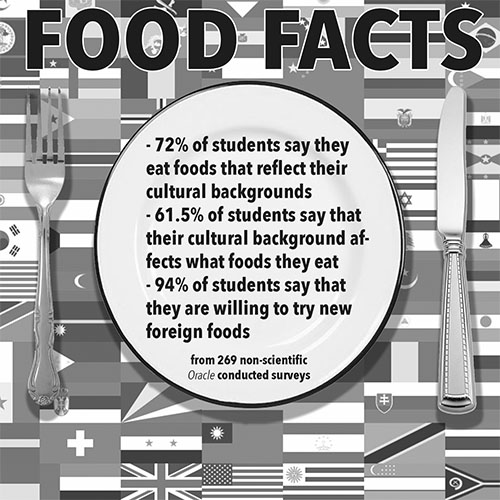Students savor cultural cuisines

Graphic by Ashley Clark
December 18, 2015
A steaming plate of crispy, triangular fried samosas has just been put in front of you at your friend’s house. Even though it might not be what you are used to, would you eat this new, foreign food? For students at South, such a situation may occur due to the culturally diverse student body. In an unscientific Oracle-conducted survey, 94 percent of students said that they are generally willing to try new foreign foods. According to Karin Davis, chef and instructor for Kendall College, food represents and reflects much of a culture.
“I can never learn enough about [cultural foods],” Davis said. “I don’t think anyone can ever learn enough about [cultural foods], because I think it’s through foods that people can really learn a lot of diversity about each other.”
In some countries and religions around the world, it is common for people to eat by the guidelines of a dietary restriction. For example, junior Max Shapiro said one guideline in the Jewish religion is keeping kosher, though a large amount of practitioners choose not to.
“I feel like a lot of the times, [being kosher] is very representative of my Jewish identity and is what distinguishes me from other people,” Shapiro said.
Freshman Hailee Bilimoria also follows specific dietary guidelines due to her ties with Indian culture and religion. According to Bilimoria, a large amount of the Indian population is vegetarian, such as Jainists, a type of Indian religion.
“My mom is Jain and my dad is Zoroastrian,” Bilimoria said. “[Jainism and Zoroastrianism] both have different viewpoints on what you can and can’t eat. [On] my mom’s side, the religion says you can’t eat any meat nor can you eat a ton of other stuff, but we only follow the meat part because it’s the major part. In Zoroastrianism, you can eat whatever.”
In addition to religious cuisine, cultural cuisines are also a major aspect in food, according to freshman Farah Mohammed-Rafee. He explained how he personally has a strong connection with Malaysian food and eats it regularly. According to Mohammed-Rafee, he eats roti canai often for breakfast. Roti canai, which is similar to a crepe, can be eaten with different types of curries, which are significant to Malaysia.
“Some people are part of a culture, but they don’t really delve into [their culture],” Mohammed-Rafee said. “They don’t really eat a lot of foods from their culture but because I eat [Malaysian] food all the time, I’m more open to my culture so I’m more aware of what I’m a part of.”
In addition to a culture’s unique cuisine, differentiations can occur when a cultures cuisines mix. According to freshman Mari Fujiki, American culture has influenced Japanese food. Fujiki explained how her travels to Japan two years ago allowed her to notice the influence that American culture has had on the country, and the different variations that exist based off of the same country’s authentic food.
“I think [American culture] has a positive effect because Japan is trying to involve a lot more American food in their culture,” Fujiki said. “I think it’s a good thing because [Japan is] becoming more international.”
Many students at South, such as senior Kiran Merchant, regularly cook cultural foods at home. Merchant explained how she feels that cooking Pakistani foods brings her closer to her background, and Pakistani cultural experiences. According to Merchant, she makes dhokla, a food eaten in Pakistan made from rice and chickpeas.
“The first time I made [dhokla] I made a lot of mistakes,” Merchant said.“My mom has her own cookbook that she has made with all her recipes that she has created over time , so I kind of used [the cookbook] as guidance.”
For some students, eating culturally or religiously-related foods also has an emotional aspect. Shapiro explained how eating foods related to Judaism makes him recall memories of his family that have gathered to celebrate various religious holidays, such as Passover. According to Shapiro, Passover is a Jewish holiday in which families congregate together and hold a small seder where they eat and have a short religious service.
“One of the things I best remember was hearing my grandfather sing songs in Yiddish back when I was a little boy and just being so inspired by him at these events to become a better Jew,” Shapiro said.
According to Bilimoria, her being both a vegetarian and someone who eats Indian food has helped her gain a different view and perspective on cultures differing from her own.
“If you’re on one side of a team, you’re going to think that your team is better than the other but if you’re using a different perspective I guess it sort of puts things in a different light,” Bilimoria said.


